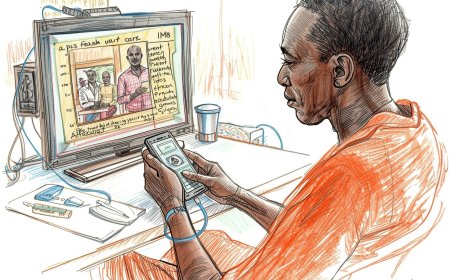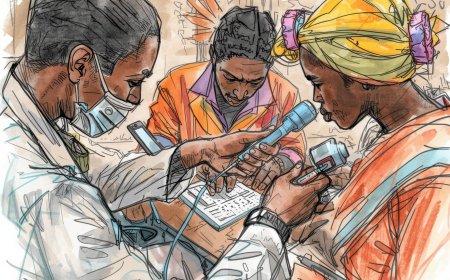Ideal Strategies to Kickstart Your Telehealth & Telemedicine Career: Start by Offering Free, Selfless Value — Do It Until Demand Lets You Charge Premium
A practical, no-nonsense guide for early-career telehealth and telemedicine professionals in Africa. Argues that the fastest, most reliable route to a sustainable, high-income telehealth practice is to start by giving (free) selfless value, solve frequent painful problems, persist until demand builds, and only then transition to premium pricing. Provides step-by-step tactics, a 90-day playbook, measurement metrics, pitfalls to avoid, and an ethical monetisation roadmap tailored to African contexts.

Early-stage telehealth and telemedicine professionals often face the same barrier: potential patients and partners don’t yet trust you enough to pay. This paper argues a counterintuitive but battle-tested strategy: begin by offering free, selfless value, persist until demand and referrals scale, intentionally solve painful and frequent problems, and master service quality — only then transition to premium pricing. The article gives practical tactics for delivering value, ways to measure traction and quality, a 90-day action plan, ethical considerations, monetisation pathways, and a checklist founders and clinicians can use to move from volunteer services to a sustainable, premium telehealth practice in African settings.
Introduction: why “give first” beats “sell fast” in telehealth
Telehealth markets in Africa are nascent, trust-dependent, and price-sensitive. Patients, clinics, employers, and payers often prefer familiar providers; digital-first entrants must overcome credibility and perceived-risk barriers. Offering free, selfless value—clinical time, education, triage, screening camps, pro bono employer pilots, or open-source tools—creates three crucial assets you cannot buy cheaply: trust, referral networks, and relevant evidence (case mix, outcomes, usage patterns). When combined with relentless focus on solving painful, frequent problems, free value becomes an investment that compounds: as more people seek you, you gain the right to charge premium prices because you are solving real, recurring pain reliably.
This is not romantic idealism — it is a practical growth and credibility strategy. Below I map the strategy to concrete actions, measurement, and an ethical monetisation transition.
The core proposition — four short rules
-
Start with free, selfless value. Offer something genuinely useful at no charge to build trust and collect real-world evidence.
-
Do it for as long as it takes. Short bursts won’t build reputation; sustained presence does. Measure progress, not time.
-
Solve painful, frequent problems. Target everyday pains (appointment access, medication advice, urgent triage, referral navigation) — high frequency means faster learning loops and faster word-of-mouth.
-
Become so good that people seek you. Master clinical quality, responsiveness, and user experience until demand increases — then convert, gradually and ethically, to paid services.
Why this works in Africa (practical logic)
-
Trust is currency. Many patients prefer known clinicians; a period of free value reduces perceived risk.
-
Referrals and social proof scale locally. Word-of-mouth in communities, employers, and clinics converts more reliably than ads.
-
You collect buyer data and proof. Free pilots yield data to build ROI cases for employers, insurers, or government buyers.
-
You learn what to charge. Real usage reveals willingness-to-pay segments; only then set premium prices and segmentation.
What “free, selfless value” actually looks like (tactical options)
Choose 1–3 options that fit your skills and context — consistency matters more than variety.
-
Regular pro bono teleclinics for underserved communities — weekly phone or SMS clinics with a fixed schedule and clear scope (e.g., chronic disease follow-ups, maternal health check-ins).
-
Employer/occupational-health pilots — offer a 3-month free teletriage service for a small company or factory in exchange for testimonials and aggregated outcome data.
-
Clinic partnership pilots — partner with a local clinic to provide after-hours remote second opinions for clinicians; clinic promotes the service.
-
Free educational content with practical utility — short WhatsApp voice notes, SMS tips, or brief video explainers for high-frequency problems (malaria triage, medication adherence).
-
Open-access triage tool or checklist — release a simple decision checklist that helps community health workers (CHWs) or families decide when to seek care.
-
Pro bono capacity-building for health workers — train nurses or CHWs to use teletriage tools, then collect referrals and improvement data.
Key features of every free offering: clear scope, measurable outcomes, reliable schedule, and a documented handoff or referral pathway.
How long is “as long as it takes”?
Don’t fix an arbitrary calendar; follow milestones. Typical sequence and indicators for transitioning:
-
Phase A (trust build — 0–3 months): weekly engagements, first 50–200 direct contacts, consistent responses within your SLAs (e.g., 24-hour response), 80% user satisfaction on quick surveys.
-
Phase B (traction & evidence — 3–9 months): steady referral growth (10–20% month-on-month), measurable process improvements (reduced missed referrals, better follow-up rates), at least one credible partner testimonial (clinic, employer, or CHW leader).
-
Phase C (demand signal & segmentation — 9–18 months): waiting lists, higher repeat-use rates, clear payer interest (local clinic or employer asks to pay), early willingness-to-pay signals (some users offer payment or ask how to pay). Only after Phase B–C metrics are met should you design premium offers.
If these milestones do not show incremental movement after 9–12 months, iterate your problem focus or distribution channel rather than quitting early.
Choosing problems to solve — how to find “painful, frequent” pains
Use the following prioritisation rubric (score each candidate use-case 1–5):
-
Frequency — how often does this problem occur in your target population?
-
Pain — how much pain, cost, or risk does it create?
-
Feasibility — can you solve it remotely with the resources and legal scope you have?
-
Measurability — can outcomes be measured reliably and quickly?
-
Payer potential — who benefits financially (patient, clinic, employer, insurer) and might pay later?
High-priority targets are high frequency, high pain, feasible remotely, measurable, and give clear payer pathways (e.g., teletriage to prevent costly referrals; chronic disease medication adherence to reduce admissions).
Practical playbook: 90-day starter plan
Days 0–7: Setup
-
Define your one-sentence value promise (e.g., “Free 24-hour consults for maternal triage in County X — weekdays 6–9pm”).
-
Create simple intake and documentation templates (paper + digital).
-
Map one local partner (clinic, CHW network, employer).
Days 8–30: Launch & outreach
-
Announce via partner channels, community leaders, WhatsApp, local radio.
-
Run small pro-bono clinics or hours; record every contact and outcome.
-
Collect short verbal/written feedback after each encounter.
Days 31–60: Iterate & collect evidence
-
Measure basic metrics weekly: encounters, repeat users, referrals, satisfaction.
-
Adjust workflow to reduce response times and clarify scope.
-
Request testimonials and permission to aggregate anonymised data.
Days 61–90: Build case & pilot monetisation conversation
-
Create a one-page evidence brief summarising outcomes (volume, satisfaction, one or two success stories).
-
Approach one payer (small employer, clinic chain, or donor) with a pilot proposal to fund a paid limited rollout — emphasise proven problem & demand.
-
Start testing a minimal paid offer for a small segment (e.g., same-day video consults for caretakers who prefer private access).
How to measure progress — KPIs that matter
Early KPIs (trust & traction):
-
Number of unique users / week.
-
% repeat users at 30 days.
-
Average response time (hours).
-
User satisfaction score (1–5).
-
Number of referrals successfully completed.
Evidence KPIs (impact & payer interest):
-
Reduction in avoidable referrals/admissions (pilot clinics).
-
Medication adherence improvements (for chronic care).
-
Employer absenteeism reductions (where employer pilots run).
-
Testimonial count and qualitative case studies.
Monetisation-ready signals:
-
Waiting list length or direct payment offers.
-
A payer requesting a funded pilot or contract.
-
Conversion of a proportion (>10–20%) of engaged users to a paid value-added service in experiments.
Transitioning to charging (ethical and tactical steps)
-
Segment users. Keep a free core for the underserved; offer premium tiers for convenience, speed, second opinions, or specialist access.
-
Communicate transparently. Tell users why you’re introducing fees, what benefits paid users get, and keep a free safety-net option.
-
Pilot prices with small groups. Test price points, gather feedback, and adjust. Use vouchers and subsidised access to avoid abrupt exclusion.
-
Bundle services. Employers and clinics pay for predictable per-employee/per-patient access; this is often easier than many small consumer payments.
-
Offer outcome-based packages to payers. For clinics or employers, propose measurable KPIs (reduced referrals, fewer sick days) as part of the contract.
-
Preserve mission. Retain the “selfless” brand in communications — this builds long-term trust and community goodwill.
Monetisation pathways (what to charge for)
-
Direct-to-consumer premium services: faster appointments, video consults, home visit coordination, specialist second opinions.
-
B2B contracts: employers, clinics, pharmacies, or NGOs paying subscription or per-user fees.
-
B2B2C / payer integration: partner with insurers or national schemes for reimbursed teleconsults.
-
Value-added services and products: chronic care bundles, remote monitoring device subscriptions.
-
Training & certification products: paid courses for CHWs or clinics trained by your service.
Pitfalls and how to avoid them
-
Giving away the “wrong” thing. Free must be valuable and relevant; free gimmicks that don’t solve real pain waste time and damage credibility.
-
Burnout from endless free work. Set reasonable time caps, rotate volunteer days, and track marginal benefit. If traction is zero after well-executed effort, change problem focus.
-
Data and legal oversights. Maintain patient privacy, clear consent, and clinical boundaries (scope of practice). Free does not mean careless.
-
Failure to measure. If you don’t track outcomes, you can’t demonstrate value to payers. Measure from day one.
-
Abrupt monetisation. Sudden paywalls alienate communities. Transition slowly with options and subsidies.
Ethical considerations
-
Always obtain informed consent for teleconsultations, even in free services.
-
Protect data: anonymise when aggregating for evidence, secure communication channels, and follow national data-protection rules.
-
Keep an access tier: free core services for the poor or critical cases, premium for convenience.
-
Avoid exploiting trust: premium offers must be transparently optional and clearly better in service, not just a means to prioritise paying patients for essential care.
Examples & mini-case templates (use these short scripts)
Community Clinic Pilot (template):
Offer: Weekly free “postnatal check-in” teleclinic (Mon & Thu 5–7pm) with documented outcomes (breastfeeding support, danger sign referrals). Evidence ask: clinic will share aggregated referral and readmission data for 6 months. Outcome goal: reduce early postpartum facility revisits by 20% among pilot cohort.
Employer Pilot (template):
Offer: 3-month free teletriage for factory employees, 24-hour response, monthly summary report of absenteeism trends. Ask: employer to allow payrolled small subsidised premium if absenteeism falls by X.
12-Point Starter Checklist (practical summary)
-
Pick one painful, frequent problem to solve.
-
Define a simple, free offer with clear scope & schedule.
-
Partner with at least one local clinic, CHW group, or employer.
-
Build intake, documentation, and consent templates.
-
Launch and advertise via partner/community channels.
-
Track core KPIs weekly (users, repeat rate, response time, satisfaction).
-
Iterate workflows to improve speed and quality.
-
Collect testimonials and anonymised outcome data.
-
Produce a one-page evidence brief at month 3 and month 6.
-
Run a small paid pilot or approach one payer after traction signals.
-
Transition to segmented pricing slowly; keep a free access tier.
-
Protect ethics and data across all phases.
Conclusion
The clearest path into a durable, premium telehealth or telemedicine career in Africa is not by charging from day one — it’s by giving first, solving urgent everyday pain, and staying long enough to build trust and demonstrable impact. Free, selfless value buys you the reputation, referrals, and data that make premium pricing credible and sustainable. Execute this strategy consistently, measure relentlessly, and monetise ethically — only then are you truly “in business.”
References
Christensen, C. M., Hall, T., Dillon, K., & Duncan, D. S. (2016). Competing Against Luck: The Story of Innovation and Customer Choice. HarperBusiness.
Ries, E. (2011). The Lean Startup: How Today's Entrepreneurs Use Continuous Innovation to Create Radically Successful Businesses. Crown Business.
Kleinman, N., & Smith, P. (2019). Building trust in digital health: Lessons for scaling in low-resource settings. Global Health Implementation Notes.
World Health Organization. (2019). Ethics and governance of digital health in low-resource settings. WHO Technical Brief.
What's Your Reaction?
 Like
0
Like
0
 Dislike
0
Dislike
0
 Love
0
Love
0
 Funny
0
Funny
0
 Angry
0
Angry
0
 Sad
0
Sad
0
 Wow
0
Wow
0














































